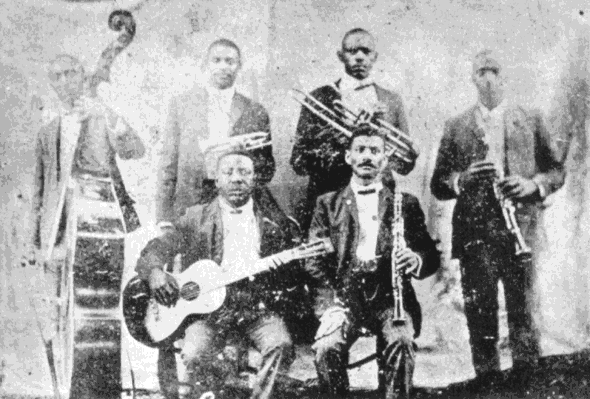1890s–1910s
Ragtime
- Main article: Ragtime

The abolition of slavery led to new opportunities for education of freed African-Americans, but strict segregation meant limited employment opportunities. Black musicians provided "low-class" entertainment at dances, in minstrel shows, and in vaudeville, and many marching bands formed. Black pianists played in bars, clubs and brothels, and ragtime developed.[13][14]
Ragtime appeared as sheet music with the African American entertainer Ernest Hogan's hit songs in 1895, and two years later Vess Ossman recorded a medley of these songs as a banjo solo "Rag Time Medley".[15][16] Also in 1897, the white composer William H. Krell published his "Mississippi Rag" as the first written piano instrumental ragtime piece. The classically-trained pianist Scott Joplin produced his "Original Rags" in the following year, then in 1899 had an international hit with "Maple Leaf Rag." He wrote numerous popular rags, including, "The Entertainer", combining syncopation, banjo figurations and sometimes call-and-response, which led to the ragtime idiom being taken up by classical composers including Claude Debussy and Igor Stravinsky. Blues music was published and popularized by W. C. Handy, whose "Memphis Blues" of 1912 and "St. Louis Blues" of 1914 both became jazz standards.[12]
New Orleans music

The music of New Orleans had a profound effect on the creation of early jazz. Many early jazz performers played in the brothels and bars of red-light district around Basin Street called "Storyville."[17] In addition, numerous marching bands played at lavish funerals arranged by the African American community. The instruments used in marching bands and dance bands became the basic instruments of jazz: brass and reeds tuned in the European 12-tone scale and drums. Small bands of primarily self-taught African American musicians, many of whom came from the funeral-procession tradition of New Orleans, played a seminal role in the development and dissemination of early jazz, traveling throughout Black communities in the Deep South and, from around 1914 on, Afro-Creole and African American musicians playing in vaudeville shows took jazz to western and northern US cities.[18]

Afro-Creole pianist Jelly Roll Morton began his career in Storyville. From 1904, he toured with vaudeville shows around southern cities, also playing in Chicago and New York. His "Jelly Roll Blues," which he composed around 1905, was published in 1915 as the first jazz arrangement in print, introducing more musicians to the New Orleans style.[19] In the northeastern United States, a "hot" style of playing ragtime had developed, notably James Reese Europe's symphonic Clef Club orchestra in New York which played a benefit concert at Carnegie Hall in 1912. [20][21] The Baltimore rag style of Eubie Blake influenced James P. Johnson's development of "Stride" piano playing, in which the right hand plays the melody, while the left hand provides the rhythm and bassline.[22]
The Original Dixieland Jass Band made the first Jazz recordings early in 1917, their "Livery Stable Blues" became the earliest Jazz recording. [23] [24] [25] [26] [27] [28] [29] That year numerous other bands made recordings featuring "jazz" in the title or band name, mostly ragtime or novelty records rather than jazz. In September 1917 W.C. Handy's Orchestra of Memphis recorded a cover version of "Livery Stable Blues".[30] In February 1918 James Reese Europe's "Hellfighters" infantry band took ragtime to Europe during World War I,[31] then on return recorded Dixieland standards including "The Darktown Strutter's Ball".[21]
3:32 AM
|
|
This entry was posted on 3:32 AM
You can follow any responses to this entry through
the RSS 2.0 feed.
You can leave a response,
or trackback from your own site.
0 comments:
Post a Comment